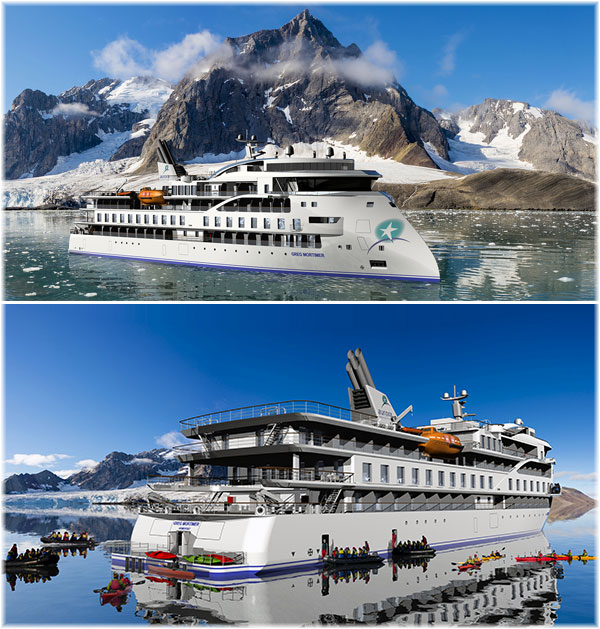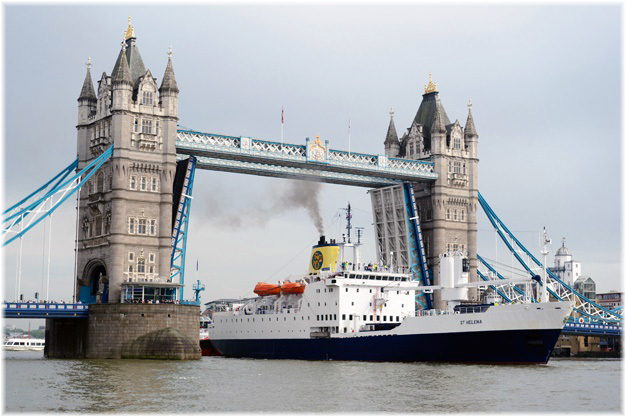China’s Arctic Policy And Aurora’s Greg Mortimer – Other Cruise News: St Helena’s Last Voyage – Voyage of the Week
 by Kevin Griffin
by Kevin Griffin
A fortnight ago China, as a Near Arctic State, released its new Arctic Policy, which happens to coincide with the construction of up to ten polar expedition ships by the China Merchants shipyard near Shanghai. The first of those ships will be Aurora Expeditions’ Greg Mortimer, one of four such ships now being built for SunStone Ships of Miami. In another realm, the supply ship St Helena made her last departure from the island of St Helena on Saturday, now that the once-distant island is served by a new airport. And this week we look at an extended 27-night two-ship three-voyage cruise being offered by Imagine Cruising in the UK on board Queen Mary 2 and Anthem of the Seas.
THIS WEEK’S STORY
China’s Arctic Policy And Aurora’s Greg Mortimer
On January 26, China issued a publication called “China’s Arctic Policy,” in which it stated that its fourth priority in the Arctic would be to develop Arctic tourism. Its first priority is to participate in developing shipping routes, second to participate in developing oil and gas resources and third to participate in Arctic fisheries. Under tourism, China stated that:
• It would advocate low-carbon tourism, ecotourism, and responsible tourism, and hopes to contribute to the sustainable development of Arctic tourism.
• As a source market for tourists to the Arctic, China would encourage its enterprises to cooperate with Arctic states in developing tourism in the region.
• It would call for continuous efforts to enhance security and rescue systems to ensure the safety of tourists in the Arctic, and that
• Its training and regulation of Chinese tourism agencies involved in Arctic tourism would endeavour to raise the environmental awareness of Chinese tourists.
• China’s participation was said to be on the basis that Arctic residents, including the indigenous peoples, will benefit from the development of Arctic resources.
China joined the International Arctic Science Committee in 1996, and since 1999 it has organised a number of scientific expeditions in the Arctic with its research ship Xue Long (Snow Dragon), which crossed the Northern Sea Route from China to Norway in 2012 and the Northwest Passage from the Atlantic to the Pacific in 2017. A second icebreaker, to be named Xue Long 2, is now being built at China’s Jiangnan Shipyard for delivery in 2019.
China has two research stations in Antarctica and one at Svalbard. It became an observer member of the Arctic Council in 2013 and its Cosco Shipping has sailed vessels through the Northern Sea Route.
Meanwhile, beyond its Arctic Policy, China already has orders to built four polar expedition ships and options to build half a dozen more, all for the account of Sunstone Ships of Miami and its clientele. Other countries too are getting in on an Arctic tourism boom.
Australian-based Aurora Expeditions, for example, has been blazing its way through ice in recent years and is due next year to introduce its first expedition ship newbuilding, the 160-berth Greg Mortimer, the first of the ships being built in China.
Aurora was the first western company to offer a full transit of the Northern Sea Route above Russia when on September 5, 2011, its chartered Russian vessel Akademik Shokalskiy became one the first ice-strengthened passenger ships to complete Russia’s Northern Sea Route, arriving at Anadyr from Murmansk with 50 passengers.

Hapag-Lloyd Cruises’ Hanseatic became the first non-Russian passenger ship to traverse the Northeast Passage (Click to enlarge)
Hapag-Lloyd Cruises’ 184-berth Hanseatic became the first non-Russian passenger ship to traverse the Northeast Passage, when she did so from Nome, Alaska, to Bodo, Norway, in 2014.
Heritage Expeditions of New Zealand, using the same Akademik Shokalskiy that Aurora had used in 2011, successfully completed a double transit of the Northern Sea Route from Anadyr to Murmansk and back in 2017.
But Aurora Expeditions will become the first operator of expedition voyages to take delivery of a vessel from a Chinese shipyard, when its Greg Mortimer is delivered in August 2019.
Aurora has teamed up with SunStone Ships to create a design for its first purpose-built expedition vessel.
SunStone Ships and China Merchants Industry Holdings (CMIH) have signed an agreement for four vessels with options for an additional six.
CMIH has in turn entered into an agreement with Norwegian ship designers Ulstein, who will supply the vessel’s design and equipment package and supervise the vessels’ construction. The 341-foot 8,000-ton Ice Class 1A vessels will be built to the latest polar code specifications.
Aurora’s Greg Mortimer will have a patented X-Bow, created by Ulstein. This is an inverted bow concept that’s been used on over 100 vessels in the shipping industry so far. But the Greg Mortimer is the first expedition cruise ship to utilise this technology.
The tapered bow results in a wave piercing effect in all wave heights, reducing pitching and bow impact loads in big seas compared to conventional bulbous bow shapes.
While a traditional bow vessel rises on the waves and then drops violently onto the surface of the water, an X-Bow vessel, less subject to the vertical motions induced by the waves, continues on course more smoothly, while maintaining its speed. Because it uses less fuel to get through the waves, it also helps to save energy.
OTHER CRUISE NEWS
St Helena’s Last Voyage
The RMS St Helena departed on her last voyage from St Helena on Saturday, February 10, one of only two in the world still to carry the title of Royal Mail Ship. The other is RMS Queen Mary 2.
The 6,767-ton St Helena has served St Helena Island from 1990 and has completed 268 voyages over her career. She originally had a capacity for 126 passengers but this was increased to 156 in 2012.
In addition to carrying passengers, the ship has been a lifeline to St Helena carrying all the Island’s goods and supplies. Now that St Helena has an airport, her replacement ship will carry cargo only.
The first St Helena, the former 3,150-ton Canadian supply ship Northland Prince, entered service in 1978. She carried 76 passengers and was used as a minesweeper support ship during the Falklands Conflict in 1982. During this time she was replaced by the 8,262-ton 196-berth Centaur, chartered from the Blue Funnel Line.
The two St Helena’s were needed to serve St Helena after the withdrawal of the Union-Castle and Safmarine mail ships that had previously served St Helena and Ascension Island. But now, the island has an airport.
Postscript: RMS St Helena left the island for the last time with an elaborate send-off only to experience a medical emergency and return to St Helena, where she called between 06:13 and 08:24 this morning, February 12.
Voyage of the Week
From time to time in future we are going to pick the odd unusual voyage and this week’s choice is a package put together by the UK’s Imagine Cruising. Imagine calls this cruise its “No-Fly Transatlantic Trail to the Caribbean” and it departs Southampton on November 18.
Using Cunard Line’s 2,750-berth Queen Mary 2 for the Transatlantic legs and Royal Caribbean International’s 4,000-berth “Quantum” class ship Anthem of the Seas for the Caribbean cruise, the choice of ships is unusal in that while the Queen Mary 2 docks in Brooklyn, the Anthem of the Seas docks on the other side of the Hudson River in Bayonne, New Jersey.
In that way, it is reminiscent of the old days in New York when cargo for ocean-going ships had to be lightered across the Harbour from the rail yards in New Jersey to the ocean docks in New York. This time coaches will do the transfer.
But this combionation has been chosen for its ships, a comparison of which follows:

The two Atllantic crossings take 7 nights each way while the11-night cruise on board Anthem of The Seas takes in five saints – San Juan, St Thomas, St Kitts, St John’s and St Maarten, followed by a two-night stay at the Millenium Hilton Hotel in New York before sailing home again in Queen Mary 2.
Fares for the full 27-night two-ship three-cruise package start at £2,299 per person for an Inside cabin, £2,599 for an Outside, £3,299 for a Balcony and £5,999 for a Grill Suite. Bookings for Balcony or above attract a free Drinks Package.
(Kevin Griffin is managing director of specialist cruise agency The Cruise People Ltd in London, England. For further information concerning cruises mentioned in this article readers can visit his blog)









